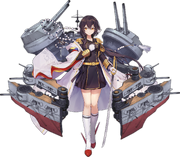
Mikasa (三笠) is a pre-dreadnought battleship built for the Imperial Japanese Navy (IJN) in the late 1890s. Named after Mount Mikasa in Nara, Japan, the ship served as the flagship of Admiral Tōgō Heihachirō throughout the Russo-Japanese War of 1904–1905, including the Battle of Port Arthur on the second day of the war and the Battles of the Yellow Sea and Tsushima. Days after the end of the war, Mikasa's magazine accidentally exploded and sank the ship. She was salvaged and her repairs took over two years to complete. Afterwards, the ship served as a coast-defence ship during World War I and supported Japanese forces during the Siberian Intervention in the Russian Civil War.
After 1922, Mikasa was decommissioned in accordance with the Washington Naval Treaty and preserved as a museum ship at Yokosuka. She was badly neglected during the post-World War II Occupation of Japan and required extensive refurbishing in the late 1950s. She has been partially restored, and is now a museum ship located at Mikasa Park in Yokosuka. Mikasa is the last remaining example of a pre-dreadnought battleship anywhere in the world.
Character
Design
- Her black uniform likely refers to her as-completed livery in 1902, where she had a black-and-white color scheme (her hull and funnels were black, but there were three identification stripes painted on her funnels and her superstructure were all in white). However, during the Russo-Japanese War and in her preserved state, she was in a darker all-grey scheme.
- The Z-flag armband is a reference to the Zulu signal hoisted by Mikasa shortly before the climactic Battle of Tsushima. It was Tōgō's concise manner of stating "The Empire's fate depends on the result of this battle, let every man do his utmost duty" in the same way Horatio Nelson had done before Trafalgar 100 years earlier.
- The "Style of the Sakura Capital" is strongly reminiscent of popular depictions of Akiyama Saneyuki, Tōgō's chief strategist and a staff officer aboard Mikasa. However, it could also just simply be a shipgirl adaptation of contemporary IJN uniform with aiguillettes.
Lines
- Her self-introduction line as a "Shikishima-class Battleship" is a reference to how she is commonly referenced in Japanese history (specifically in pixiv fanart, the Japanese wikipedia, and Wargaming's Japanese historical consultant) as the four pre-dreadnoughts Shikishima, Hatsuse, Asahi, and Mikasa were all collectively ordered in the UK after the First Sino-Japanese War. However, in English literature she is commonly referred to as a "Mikasa-class Battleship" as she was built to a different design (modified Formidable instead of modified Majestic), had two funnels instead of Shikishima's 3, and was the first Japanese battleship to feature Krupp Cemented Armor.
- Her lines about leading reflect the fact that she commonly lead the combined fleet to battle in their numerous engagements against Russia in the Russo-Japanese War.
- "Pressing forwards to victory" is a reference to the fact that Tōgō and the Japanese Combined Fleet aggressively pursued the Russian Baltic Fleet before, during, and shortly after the Battle of Tsushima. It was Tōgō's express objective to see the complete destruction of the Baltic Fleet to prevent them from escaping to Vladivostok.
- Her idle line about the Royal Cuisine reflects the fact that (like Kongō and most early IJN armored cruisers and battleships) Mikasa was built in the United Kingdom, specifically in Barrows-in-Furness by Vickers.
- For some reason Mikasa is largely unaware of aircraft, despite the fact that her commander was personally visited by the British Sempill Mission seeking to bolster Japanese aviation or the fact that Japan launched one of the world's first naval air-raids at the Battle of Qingdao (Tsingtao) in World War I.
- Her Special Touch line is a possible reference to the fact that Mikasa was briefly a dance hall and an aquarium after World War II.
